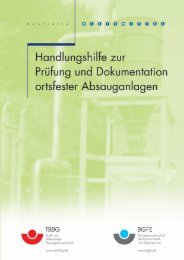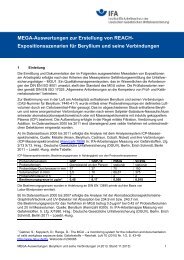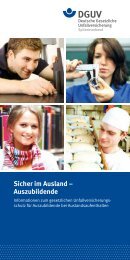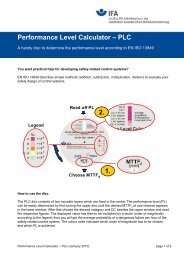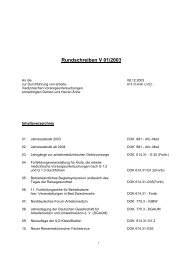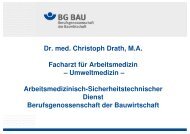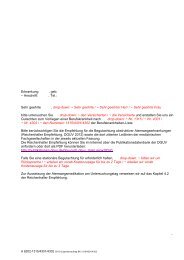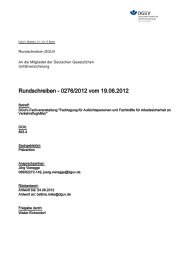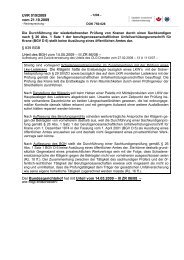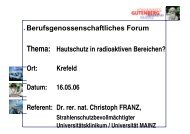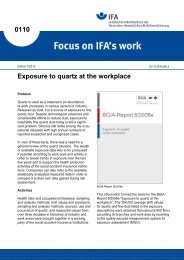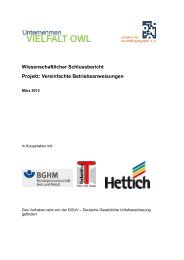Effectiveness of measures to prevent needlestick injuries among ...
Effectiveness of measures to prevent needlestick injuries among ...
Effectiveness of measures to prevent needlestick injuries among ...
Create successful ePaper yourself
Turn your PDF publications into a flip-book with our unique Google optimized e-Paper software.
4 Intervention program evaluation<br />
(Bioplexus, Inc.), and Venipuncture Needle Pro resheathable vacuum tube blood-<br />
collection needles (Protex Inc.) for phlebo<strong>to</strong>my [37; 38]. The ten participating hospitals<br />
did not use standardized reporting methods: some relied on institutional injury sur-<br />
veillance policies and data collection, while others surveyed their employees specifi-<br />
cally for this evaluation. In spite <strong>of</strong> documented differences in data collection methods<br />
and associated differences in likelihood <strong>of</strong> completeness, and therefore, potential for<br />
bias, the authors combined data from all ten hospitals for their efficacy analysis.<br />
Completeness <strong>of</strong> reporting, assessed by comparing interview (recall) results for a<br />
sample <strong>of</strong> participants with the number <strong>of</strong> phlebo<strong>to</strong>my-related NSI reported at the<br />
institution level, was about 90 %. Although the authors concluded that the three<br />
selected replacement devices reduced NSI rates when compared with conventional<br />
devices, they were not able <strong>to</strong> verify that conventional equipment had, in fact, been<br />
replaced.<br />
Trape-Cardoso et al. [39] used passive surveillance data available from the NaSH<br />
system for an ecological evaluation <strong>of</strong> the effectiveness <strong>of</strong> multiple interventions intro-<br />
duced between 1997 and 2002. In addition <strong>to</strong> safety piggyback (interlink) systems,<br />
safety butterfly needles, retractable lancets, and, eventually, replacements for all<br />
needles attached <strong>to</strong> syringes, administrative and educational interventions were<br />
also implemented. Specific product names or manufacturers were not specified.<br />
From unadjusted analyses, the authors concluded that NSI <strong>to</strong> medical and dental<br />
students and nursing staff declined over a five-year period. Reported incidence rates<br />
decreased from 7.9 % in 2000 <strong>to</strong> 2001 <strong>to</strong> 2.6 % in 2001 <strong>to</strong> 2002 for students, and<br />
from 9.2 % in 1997 <strong>to</strong> 1998 <strong>to</strong> 2.7 % in 2001 <strong>to</strong> 2002 for nursing staff. There was<br />
also a small decrease in NSI <strong>among</strong> residents, but the effect was temporary. The<br />
reversal <strong>of</strong> the trend in NSI <strong>among</strong> residents argues against a causal effect <strong>of</strong> the<br />
interventions, and suggests the possibility <strong>of</strong> differential completeness <strong>of</strong> reporting by<br />
HCW category. If the devices were effective at reducing NSI, the effect should have<br />
been seen <strong>among</strong> all potential users and should not have been transient.<br />
Younger et al. [40] evaluated the Monoject Safety Syringe (Sherwood Medical), a<br />
shielded 3 cc safety syringe. Three participating medical centers reported the number<br />
<strong>of</strong> NSI <strong>among</strong> staff relative <strong>to</strong> the number <strong>of</strong> inven<strong>to</strong>ry units ordered per year. Younger<br />
Report „Needlestick <strong>injuries</strong>“ 37



